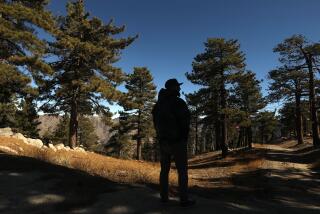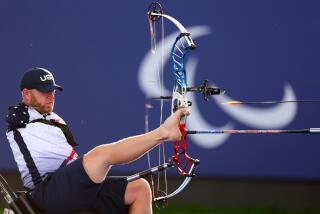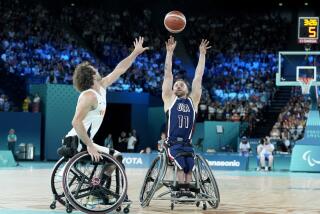The Fall Defeats the Fear
ALPINE MEADOWS, Calif. â The sky is a brilliant blue, the ski runs are freshly groomed and thereâs a prosthetic leg -- no person attached -- planted in the snow by the lift.
The fake limb belongs to Eric Taylor, 34. He is schussing quickly down the mountain on his good leg, happy not to bother with his artificial one. It just gets in the way.
And then Taylor wipes out. Big-time. Itâs a yard sale, in the language of skiers. A small cornice of snow clings to a nostril after he rises. He dusts off the snow and resumes carving his way down the mountain.
Once the domain of able-bodied skiers, the mountains now draw more and more disabled people like Taylor. They not only can ski -- they often can ski well.
The list of those hitting the slopes includes multiple amputees, quadriplegics, the deaf, the blind and those with Downâs syndrome, muscular dystrophy, multiple sclerosis and cerebral palsy.
âSometimes Iâm asked the question, âIsnât it risky?â â says Doug Pringle, director of the Tahoe Adaptive Ski School, where Taylor serves as a volunteer. âI tell people thereâs dignity in risk. Everyone has to learn to fall down and get back up again.â
Taylor has spent much of his life falling down and getting up.
Neurofibromatosis caused tumors to smother the nerve endings in his lower right leg. When he was 3, doctors amputated below the knee to save the remainder of the leg.
It didnât scare him away from skiing, a sport his parents loved. Initially, he skied with his prosthesis. But there were awkward moments. Several years ago, his artificial leg fell off while he was riding a lift. On another occasion, a violent crash rotated his prosthesis 180 degrees. When members of the ski patrol arrived, they found -- to their horror -- a downed skier whose foot was pointing backward.
âI told them, âJust give me an Allen wrench and I can fix it,â â recalls Taylor. âThey thought I was in severe shock.â
Taylor tells these stories to a reporter between runs down a well-pitched slope at Alpine Meadows, with Lake Tahoe shimmering in the distance. It quickly becomes apparent that Taylor is a fine skier. Although he uses only one ski, two poles with short skis on the bottom help him stay balanced.
The more he skis, the more apparent it becomes that he is fearless, competitive and, as his occasional wipeouts prove, very resilient. An hour later, when Taylor and the reporter part ways, he quips: âItâs nice to finally ski with someone who can keep up with me.â
The ski industry has for years performed a collective face-plant trying to persuade more able-bodied people to take up the sport. The number of skiers and snowboarders has remained between 12 million and 13 million for 15 years, according to industry estimates.
A 1999 survey by Snowsports Industries America, a trade group that represents equipment makers, found several reasons for the lack of growth. The No. 1 reason people gave was that they had no one to ski with. Reasons 2 through 5 all had to do with fear of falling.
Devoted disabled skiers seem to have no such fear.
At least 11 million severely disabled people live in the United States, according to the National Institutes of Health. No definitive statistics are kept on how many ski or snowboard, but ski schools serving the disabled across the West report that the number is at least 10,000 and rising steadily.
Skiing by the disabled began after World War II, as soldiers returned home missing limbs just as ski resorts were beginning to flourish. But the sport didnât really take off until the Vietnam War, when disabled young veterans found solace on the slopes.
Some of those soldiers formed the first nonprofit ski schools in the nation. Those vets âwere the apostles,â said Pringle, who took up and later promoted adaptive skiing after losing part of a leg in Vietnam.
As more adaptive equipment was developed, more disabled people learned to ski. The Americans With Disabilities Act of 1990 helped remove some of the last barriers to the slopes by making it clear that resorts had to accommodate anyone interested in learning to ski.
The technology has improved with time -- although it isnât necessarily complex. Sometimes the equipment is as simple as poles with skis or a harness that attaches an instructor to a student.
Sometimes itâs a matter of technique, not technology. Skilled blind skiers negotiate mountains -- and even race -- by schussing several feet in front of or behind a guide who shouts instructions such as âright turn!â âdrop!â or âstop now!â
On a crisp February morning, five students of varying skill levels gather at the Tahoe Adaptive Ski School. They will do their share -- and then some -- of falling and crashing.
Beth Jones, 13, of Orinda wears a helmet and goggles and sits in a mono-ski, a chair attached to a single ski. She is quiet and determined.
She also skis fast -- sometimes too fast.
âRight turn! Right turn!â screams her instructor, but Beth is not leaning far enough to the side to execute the turn.
Instead, in a NASCAR moment, she smacks into a snowbank and performs a half-flip. She comes to rest on her side on top of the snowbank, still strapped into the ski and peering down into a gully.
âOK,â she says, smiling.
Beth was born with spina bifida, which prevents the spine from fully developing. She canât walk.
Later at lunch, she sits in her wheelchair with her family and indulges in a time-honored ski tradition: She brags about her crash.
Another student is Jack Tuchman, a 7-year-old with curly blond hair. The boy has never spoken a word, although his hearing is good.
No one knows exactly whatâs wrong with Jack, says his mother, Daren Tuchman, 39, of Menlo Park. Doctors say an acute developmental disorder impaired his ability to learn and communicate. But, despite years of trying, they have been unable to diagnose the exact problem.
Jackâs mother, a lifelong skier, made the decision long ago that her three children would also ski -- Jack included.
An instructor at the school puts Jack in a harness and binds the tips of his skis together -- to keep him from going splay-legged. A few moments later, heâs skiing at a modest clip.
Jack claps as he skis. He seems to like it. Heâs in mid-clap when he takes a minor spill.
âPart of Jackâs disability is that he doesnât understand his own limitations,â says Tuchman. âI know this isnât risk-free. But maybe thatâs why he is stimulated by it -- because he knows he can fall.â
Many disabled skiers take up the sport to give their supposed limits a shove.
âMaybe in the past people said, âBe happy youâre alive,â but the prevailing attitude is, there is no reason to hold back,â said Brian Davis, an assistant professor of physical medicine and rehabilitation at UC Davis.
Davis and other doctors say that the biggest risk for disabled people today is to do nothing. Heart disease is a major risk for inactive people, as is depression, especially after catastrophic injuries.
âIf everything you love is taken away, what does that do to you?â asks KelLe Malkewitz, executive director of the United States Adaptive Recreation Center in Big Bear.
Some disabled people have found that their handicaps were not as limiting as they had imagined.
âLook, I consider myself to be an able-bodied person,â says Jenny Zimmer, 18, of Pleasanton, who has cerebral palsy and aspires to race competitively as a disabled skier.
âI want to be treated like everybody else,â she adds, as she clambers out of her wheelchair and stands on her knees while wrestling on a sweater. âCerebral palsy is not a bad thing. Itâs a challenge, thatâs all.â
At Zimmerâs first ski lesson five years ago, the instructor sat her down and tried to give her an inspirational talk.
âI finally told him to shut up, I wanted to ski,â she says.
*
In 1968, Doug Pringle was two hours into a firefight with the Viet Cong in the Mekong Delta when a rocket-propelled grenade sheared off his right leg just below the knee.
Pringle survived an emergency operation and spent the next 18 months at the veterans hospital at the Presidio in San Francisco, enduring numerous âstump repairâ surgeries.
Then, one day, some disabled veterans arrived at the VA with a home movie of amputees skiing. When the film ended, they asked: Who wants to try?
Pringle declined. His one stab at skiing on two legs before the war had been a disaster.
âSo, some guys went up and came back and said it was great: âWe got drunk, and there were women,â â recalls Pringle. âI said, âSign me up.â â
Pringle and other disabled vets became amputee ski bums, traveling to the Donner Summit resorts in the Sierra Nevada nearly every weekend.
Some resorts balked, citing safety concerns. In the 1990s, a group of disabled people took Squaw Valley to court, pressing the giant Tahoe resort to allow wheelchairs on the gondola serving a mid-mountain ski lodge.
In addition, they argued that the resort was in violation of the Americans with Disabilities Act, because the lodge couldnât be navigated with wheelchairs.
Squaw Valley settled the suit, agreeing to modify the lodge and open its mountain to disabled skiers at a steeply discounted price. The improvements cost more than $1 million. Today, all ski resorts must be handicapped-accessible and offer adaptive lessons. Most of those lessons are provided by nonprofit schools.
Money remains an issue. The Tahoe Adaptive school, for example, relies on a bingo hall for about half its budget, or $470,000 in 2002.
But Indian gaming has taken a bite out of the bingo business. In the future, Pringle says, theyâll probably have to look elsewhere for money.
*
In 1982, Mark Wellman, 43, of Truckee, was paralyzed in a climbing accident. In 1989, he became the first paraplegic to climb the more than 3,000-foot vertical face of El Capitan in Yosemite National Park. Using special gear, he essentially pulled himself up his climbing rope with his arms.
At Alpine Meadows, Wellman is skiing with a friend, Jon Arnow, 47, a Reno physician whose legs were left partially paralyzed when he broke his back while skiing in 2002.
Although Wellman and Arnow need some help getting their equipment to the slopes, once on the snow, both are self-reliant. They wait in line for lifts sitting on their spring-loaded mono-skis, balancing with their poles, âhoppingâ aboard as the lift comes around. On the way down, after spills, they rely heavily on arm strength -- or sometimes a helping hand -- to get up.
At the top of the Roundhouse lift, Wellman says something about âskiing the rough stuffâ as he and Arnow veer off trail, down a steep hill laden with trees and bumps.
They look like two guys who have hurled themselves off a cliff in chairs.
âI canât run. I canât walk well. I canât ski upright. Thereâs a lot I canât do,â Arnow said later. But he was a proficient skier before his accident, and he clearly hasnât lost the knack.
âSkiing was like breathing for me,â he said. âAnd it still is.â


